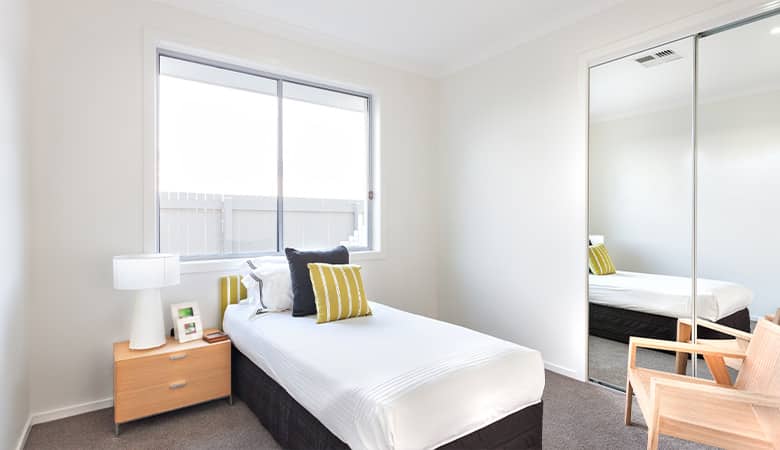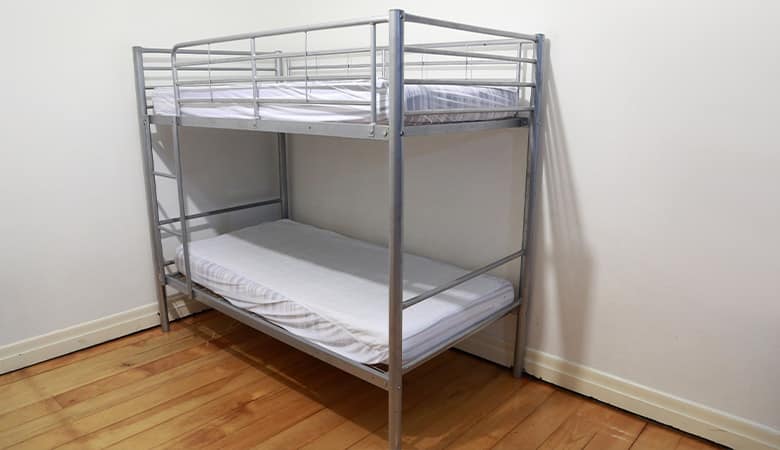Your bedroom is a sanctuary of rest and comfort. It should be cosy and calm. A place to unwind and relax after a busy day. If you’re lucky enough to be building a bedroom from scratch, this post will help you decide on the size of your bedroom.
So, what is the ideal bedroom size? The ideal size for a bedroom with a queen size bed is 12 square meters. Or about 130 square feet. With that said, this will depend on how many people use the bedroom, the size of your bed, how many beds there are in the room, and whether or not you’re in a wheelchair.
While it is easy to just give you a number for the ideal size of a bedroom, there are many factors that you need to take into consideration before you decide on the size of your bedroom. Let’s dive in.
Starting your day the right way

Our bedroom is the room in the house where we spend the most time. While we spend most of this time asleep, it’s where we start and end the day. And I don’t think I need to tell you why this is important.
Getting the size of your bedroom wrong might mean that you wake up in a bad mood because you subconsciously feel cramped in a small bedroom. Or maybe you battle to fall asleep in a big bedroom because it doesn’t feel cosy and safe.
The main piece of furniture in your bedroom is, obviously, the bed. And this is a good place to start when you are trying to decide on the size of your bedroom.
It’s recommended that you have at least 76 centimeters (30 inches) all the way around your bed to have ample circulation space. Anything less than this will be cramped and hard to move around your bedroom.
We all know that sleeping is not the only thing that you do in your bedroom. The next thing to consider is what other furniture you need in your bedroom, how much storage you need, and what do you do in your bedroom besides sleeping.
Make space for more than just sleeping
The important part is having enough space around the bed for other bedroom activities. Things like getting dressed, getting ready for your day, and getting in and out of bed.
Depending on your lifestyle, you might need a dresser with a mirror to do your makeup. Consider including a reading nook to have a quiet spot to retreat to before you go to sleep.
And don’t forget a full length mirror. A full length mirror is essential for making sure your shoes go with your outfit before you go out into the world and conquer the day.
If your wardrobe is in your bedroom, make sure that there is enough room to open the doors without clashing with your bed. There should also be enough room for you to stand between the bed and the OPEN wardrobe doors.
Now that we’ve got that out of the way, let’s dig into some more detailed examples about the size of your bedroom.
Single beds

The standard size for a bedroom containing one single bed is 2,13 meters x 2,13 meters. It is possible to go smaller, but this will feel very cramped. In fact, in the UK, you cannot list a room smaller than this as a bedroom on your real estate listing. So consider this carefully if you are thinking about making a bedroom smaller than the measurements above.
A bedroom of this size will be enough for a children’s bedroom. There would be enough space for one wardrobe and a bedside table.
Two single beds
If you are designing a bedroom with two single beds, you obviously need to account for the extra bed and possibly another wardrobe. The absolute minimum would be 2,75 meters x 2,75 meters. At this size, there wouldn’t be much circulation space and the wardrobes would have to be small.
If you increase the size to 3,05 meters x 3,05 meters then you will have a more comfortable bedroom with space for bigger wardrobes.
Bunk beds

Another option would be to stack the beds on top of eachother. While this gives you more floor space, try and resist the urge to make the room much smaller than the measurements above. Remember that a room with two beds is still designed for two people to live there. So they would need extra circulation and storage space.
If you decide to go the bunk bed route, make sure your ceiling is high enough to fit a bunk bed in the space.
Make sure that your ceiling is at least 2,7 meters high if you are considering bunk beds.
Double bed
Next up: the double bed. To fit a double bed comfortably in a bedroom, you will need at least 2,7 meters x 2,9 meters. This would be a small bedroom for a double bed, and wouldn’t have much space for storage.
If you increase the size of the bedroom to 3,5 meters x 3,5 meters then you will have enough space for plenty of storage space as well as a dressing table to do your makeup and hair.
Queen bed
The minimum bedroom size for fitting a queen bed is 2,9 meters x 3,05 meters. Once again, this is a minimum and there won’t be much storage space.
Scaling that size up to 3,5 meters x 3,5 meters will give space for wardrobes, a dressing table and possibly even a desk. It’s important to consider your lifestyle and think about what you do and store in your bedroom.
Bigger is not always better
If you are lucky enough to be building a house from scratch, it is very easy to overestimate how much space you actually need. When designing your bedroom, it’s important not to fall into this trap.
A bedroom that is too big is at risk of feeling too impersonal and open. Your bedroom should be a cosy and comfortable haven, and big rooms rarely have this quality.
So there you have it, start with the size of your bed, consider your lifestyle and what you store in your bedroom, and don’t go too big when it comes to designing the bedroom of your dreams.
